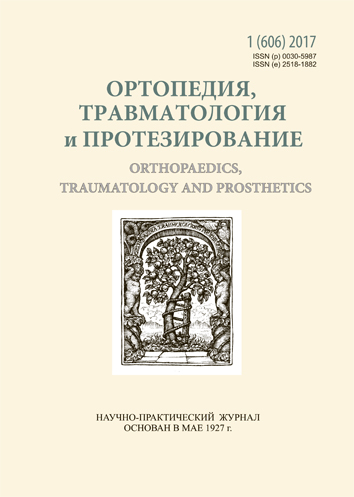Morphological characteristics and correlation of chronic hematogenous osteomyelitis with latent clinical course (Garre type)
DOI:
https://doi.org/10.15674/0030-5987201715-13Keywords:
sclerosing hematogenous os¬teomyelitis, pathohistological features, morphological indices, correlation analysisAbstract
One of the clinico-morphological variants of osteomyelitis with latent course is sclerosing hematogenous osteomyelitis of the Garre type.
Objective: on the basis of pathomorphological and gradation-morphometric studies of bone lesion, establish statistical differences between individual forms and correlation links between the morphological indices of lesions of the bone of patients with sclerosing hematogenous osteomyelitis.
Methods: fragments of affected bones of 25 patients with clinically established sclerosing hematogenous osteomyelitis were studied. On the basis of pathohistological study, morphological indices were identified, with the use of which gradation-frequency and correlation analysis of nonparametric data was carried out with the calculation of the association coefficient.
Results: despite the general similarity of morphological manifestations, differences in the forms of sclerosing hematogenous osteomyelitis were established: about ⅔ of all cases corresponded to the fibrosing form of the focus without the presence of exudative inflammation. In the remaining cases, in addition to fibrosis and osteosclerosis, the foci of osteomyelitis contained microabscesses, within which small sequestrations were found. Forms of foci of sclerosing hematogenous osteomyelitis can eventually move from one to another. Between the fibrotic with micro-abscess formation of sclerosing hematogenous osteomyelitis and the presence of microsequesters in the microabscesses, a reliable positive correlation was found between the mean force (ra= +0.620). Sequesters in tissues were not observed in the foci of fibrosis.
Conclusions: sclerosing hematogenous osteomyelitis is a clinical variant with a latent course mainly in adolescent patients, in which there is no macrodefective damage to the bone marrow and bone tissue by an infectious inflammatory process, namely: large abscesses, significant sequestration, parasseous abscesses and fistulas.References
- Roy M, Somerson JS, Kerr KG, Conroy JL. Pathophysiology and pathogenesis of osteomyelitis. Osteomyelitis. Ed. M. S. Baptista. InTech, 2012. Available from: http://www.intechopen.com/books/osteomyelitis/ pathophysiology-and-pathogenesis.
- Ceroni D, Kampouroglou G, Valaikaite R, Anderson della Llana R, Salvo D. Osteoarticular infections in young children: what has changed over the last years? Swiss Med Wkly. 2014;144:w13971. doi: 10.4414/smw.2014.13971.
- Dartnell J, Ramachandran M, Katchburian M. Haematogenuous acute and subacute paediatric osteomyelitis. A systematic review of the literature. J Bone Joint Surg Br. 2012;94(5):584–95. doi: 10.1302/0301-620X.94B5.28523.
- Hryhorovskyi V, Hrytsai MP, Hordii AS, Hryhorovska AV. Features of clinical and morphological picture and diagnostics of «atypical forms» of hematogenous osteomyelitis of long bones. Orthopaedics, Traumatology and Prosthetics. 2015;(1):5-11. doi: 10.15674/0030-5987201515-11. (in Ukrainian)
- Hryhorovskyi V. Aspects of pathomorphology and nomenclature in the modern classification of nonspecific osteomyelitis. Orthopaedics, Traumatology and Prosthetics. 2013;(3):77-87. doi: 10.15674/0030-59872013377-87/ (in Russian)
- Segev E1, Hayek S, Lokiec F, Ezra E, Issakov J, Wientroub S. Primary chronic sclerosing (Garré’s) osteomyelitis in children. J Pediatr Orthop. 2001;10(4):360–4.
- Franco-Jiménez S, Romero-Aguilar JF, Bervel-Clemente S, Martínez-Váquez M, Alvarez-Benito N, Grande-Gutiérrez P, Maldonado-Yanza RG. Garre’s chronic sclerosing osteomyelitis with sacral involvement in a child. Rev Esp Cir Ortop Traumatol. 2013;57(2):145–9. doi: 10.1016/j.recot.2012.11.003.
- Bruder E, Jundt G, Eyrich G. Pathology of osteomyelitis. Osteomyelitis of the jaws. Eds. MM Baltensperger, GKH Eyrich. Springer Berlin Heidelberg, 2009, pp.121–33.
- Baltensperger M, Grätz K, Bruder E, Lebeda R, Makek M, Eyrich G. Is primary chronic osteomyelitis a uniform disease? Proposal of a classification based on a retrospective analysis of patients treated in the past 30 years. J Craniomaxillofacial Surg. 2004;32(1):43–50. doi: 10.1016/j.jcms.2003.07.008.
- Vienne P, Exner GU. Osteomyelitis Sclerosans Garré. Orthopade. 1997:B26(10):902–7. doi: 10.1007/PL00003340.
- Jones HW, Beckles VL, Akinola B, Stevenson AJ, Harrison WJ. Chronic haematogenous osteomyelitis in children. An un¬solved problem. J Bone Joint Surg Br. — 2011;93-B(8):1005–10. doi: 10.1302/0301-620X.93B8.25951.
- Jones HW, Beckles VL, Akinola B, Stevenson AJ, Harrison WJ. New treatment option for sclerosing osteomyelitis of Garré. J Pediatr Orthop B. 2013;22(6):577–82. doi: 10.1097/BPB.0b013e32836330a6.
- de Moraes FB, Motta TM, Severin AA, de Alencar Faria D, de Oliveira César F, de Souza Carneiro S. Garré’s sclerosing osteomyelitis: case report. Rev Bras Ortop. 2014;49(4):401–4. doi: 10.1016/j. rboe.2014.04.010.
Downloads
How to Cite
Issue
Section
License
Copyright (c) 2017 Valeriy Hryhorovskyi, Mykola Hrytsai, Andrew Hordii, Olga Lyutko, Anastasiya Hryhorovska

This work is licensed under a Creative Commons Attribution 4.0 International License.
The authors retain the right of authorship of their manuscript and pass the journal the right of the first publication of this article, which automatically become available from the date of publication under the terms of Creative Commons Attribution License, which allows others to freely distribute the published manuscript with mandatory linking to authors of the original research and the first publication of this one in this journal.
Authors have the right to enter into a separate supplemental agreement on the additional non-exclusive distribution of manuscript in the form in which it was published by the journal (i.e. to put work in electronic storage of an institution or publish as a part of the book) while maintaining the reference to the first publication of the manuscript in this journal.
The editorial policy of the journal allows authors and encourages manuscript accommodation online (i.e. in storage of an institution or on the personal websites) as before submission of the manuscript to the editorial office, and during its editorial processing because it contributes to productive scientific discussion and positively affects the efficiency and dynamics of the published manuscript citation (see The Effect of Open Access).














